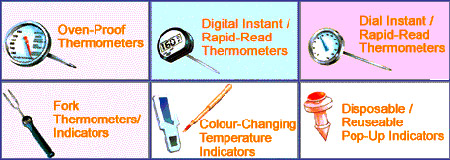|
Less than one in five Canadians regularly use the one kitchen tool
that can ensure meat and poultry is safe and cooked to perfection
- a food thermometer. In fact, most Canadians do NOT even own one.
With barbeque season underway, the food thermometer should be your
gift to the good health of you and your family. Food safety experts
say that using a thermometer is the only sure way to prevent a potential
food poisoning disaster…and food poisoning could kill you!
A gift for the grilling season - a food thermometer!
- Cook beef to perfection, so that it is tasty and juicy - not overdone.
Use a food thermometer to judge when beef is cooked.
- Cook to safe internal temperatures (see chart below).
- Be especially careful if you're cooking for those at high risk
of serious illness from food borne bacteria -infants/young children,
pregnant women, older adults or those with chronic illness.
- Using a food thermometer or temperature indicator is the ONLY
reliable way to test for safe internal temperatures.
Which is the best thermometer to use?
Buy a good quality, digital instant-read thermometer or thermometer
fork that gives a temperature reading, not just a doneness range.
This thermometer type can be used in all foods and if used when preparing
just one of your daily meals, it will cost you less than 3 cents per
day (based on a 3 year lifespan for a $35 thermometer).
Some thermometers stay in foods while they cook; others do not. Some
are ideal for checking thin foods like burgers; others are good just
for roasts. We've test driven most of the varieties out there (in
a price range under $40) and have pulled together what you need to
know to choose and use the type that's best for you!

Thermometer Know-How
- Insert instant-read thermometer stem or fork thermometer tines
sideways into the centre of patties/steak or centre of thickest
part of a roast or meatloaf. Insert to a depth of at least 1 1/2"(4
cm), away from bone, fat or gristle.
- Leave thermometer in food for at least 30 seconds before reading
temperature.
- When beef roast or cut has an irregular shape, check the temperature
in several places.
- Always use hot soapy water to wash the tongs, plate and thermometer
stem used in checking partially cooked meats before using again.
- Review manufacturers' guidelines specific to the care of your
thermometer or temperature indicator.
- Take temperatures of thin foods like burgers within 1 minute of
removal from heat.
- For larger cuts like roasts, remove from oven and tent with foil;
check temperature after 5 to 10 minutes.
- Cook ground beef completely, until it reaches 160°F (71°C).
Don't rely on the 'colour test' to know when burgers are done. Recent
research shows that the colour of cooked ground beef can vary -
burgers may be brown in the centre before being cooked to a safe
temperature.

Experts agree that it's the chefs in your kitchen and at the backyard
barbecue who can make or break the weekend. From a safety standpoint,
appearance isn't a reliable indicator. Beef burgers may be brown in
the centre before reaching a safe temperature or they can remain pink
even after proper cooking.
Undercooked ground beef can be a source of E. coli 0157:87, a bacteria
that can cause severe stomach distress, including vomiting and diarrhea.
In the worst cases -- especially in older people, children, or people
whose immune defenses are compromised -- contamination with E.coli
can lead to kidney failure.
"The main risk with E.coli is in ground beef," he says.
"That's because the meat can become contaminated in the slaughtering
process. If you buy a steak contaminated on its surface and you grill
the steak, the bacteria get scorched." Not so with ground beef,
Schaffner says. "Here you take a lot of steak, and the bacteria
is ground up and mixed in. Now you have a patty with bacteria on the
surface and on the interior. That is why we say if you are going to
grill a hamburger, you should cook it all the way through - no red
spots and no pink spots."
Food safety specialists at Kansas State University
offer the following tips for grilling burgers:
- Start with clean hands, a clean work surface; and fresh meat.
Gently shape ground beef into patties and place them on a clean
plate or platter. Cover and refrigerate the hamburger patties until
ready to cook or grill.
- Defrost frozen patties on a covered plate or platter in the refrigerator.
Place the plate or platter on the bottom shelf of the refrigerator
to prevent meat juices from dripping on other fresh foods. Thaw
frozen patties completely -- partially thawed patties may not cook
evenly.
- After handling raw meat, wash hands thoroughly. Clean and sanitize
utensils and work surface.
- Cook the hamburger patties over medium heat, or grill them over
medium, ash-colored coals. Grill two-inch thick patties 11-13 minutes
or until the center reaches 160 F. Use a long-handled spatula or
grill tongs to turn burgers half way through cooking, and do not
press or flatten burgers. Doing so may force out flavorful juices
and make the hamburgers taste dry.
- Is it done yet? Use a meat thermometer to check end-point temperature.
- Use a clean spatula or grill tongs to transfer fresh-cooked hamburgers
to a clean plate or platter. Do not use the same platter or plate
that was used for raw patties unless it has been washed and sanitized.
- Refrigerate leftovers promptly; before serving, reheat completely.
|
|


